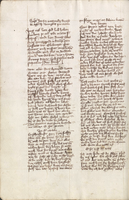|
|
You are not currently logged in. Are you accessing the unsecure (http) portal? Click here to switch to the secure portal. |
Difference between revisions of "H. Beringer"
| Line 189: | Line 189: | ||
| <small>34</small> | | <small>34</small> | ||
| <br/><br/> | | <br/><br/> | ||
| + | |||
| + | |} | ||
| + | | {{section|Page:MS G.B.f.18a 123v.png|5|lbl=-}} | ||
| + | | <p><br/></p> | ||
| + | |||
| + | {{section|Page:MS Q566 147v.jpg|4|lbl=147v|p=1}}<br/>{{section|Page:MS Q566 148r.jpg|5|lbl=148r|p=1}} | ||
| + | |||
| + | |- | ||
| + | | | ||
| + | {| class="zettel" | ||
|- | |- | ||
| <small>35</small> | | <small>35</small> | ||
| Line 225: | Line 235: | ||
| <small>46</small> | | <small>46</small> | ||
| Jerk/redraw, if he jerks, jerk more—<br/>work he will find, the step into. | | Jerk/redraw, if he jerks, jerk more—<br/>work he will find, the step into. | ||
| + | |} | ||
| + | | | ||
| + | <br/><br/>{{section|Page:MS G.B.f.18a 123v.png|6|lbl=-|p=1}} | ||
| + | | | ||
| + | {{section|Page:MS Q566 148r.jpg|8|lbl=-|p=1}}<br/><br/><br/>{{section|Page:MS Q566 147v.jpg|7|lbl=147v|p=1}}<br/>{{section|Page:MS Q566 147v.jpg|5|lbl=-|p=1}}<br/>{{section|Page:MS Q566 147v.jpg|6|lbl=-|p=1}}<br/><br/><br/>{{section|Page:MS Q566 147v.jpg|8|lbl=-|p=1}} | ||
| + | |||
| + | |- | ||
| + | | | ||
| + | {| class="zettel" | ||
|- | |- | ||
| <small>47</small> | | <small>47</small> | ||
| Line 259: | Line 278: | ||
| Four are the cuts,<br/>two below and with them two above. | | Four are the cuts,<br/>two below and with them two above. | ||
|} | |} | ||
| − | | | + | | |
| − | + | <br/><br/>{{section|Page:MS G.B.f.18a 123v.png|7|lbl=-|p=1}} | |
| − | + | | | |
| − | {{section|Page:MS | + | {{section|Page:MS Q566 148r.jpg|7|lbl=148r|p=1}}<br/>{{section|Page:MS Q566 148r.jpg|3|lbl=-|p=1}}<br/>{{section|Page:MS Q566 148r.jpg|6|lbl=-|p=1}}<br/>{{section|Page:MS Q566 148r.jpg|4|lbl=-|p=1}} |
|- | |- | ||
| <p>'''And this is the end of the art.'''</p> | | <p>'''And this is the end of the art.'''</p> | ||
| − | | {{section|Page:MS G.B.f.18a 123v.png| | + | | {{section|Page:MS G.B.f.18a 123v.png|8|lbl=-}} |
| | | | ||
Revision as of 17:02, 26 July 2017
| Modus Dimicandi | |
|---|---|
| Method of Fighting | |

| |
| Ascribed to | H. Beringer |
| Genre | |
| Language | |
| Archetype(s) | MS G.B.f.18a (1418-28) |
| Manuscript(s) | MS Q.566 (1479) |
| Concordance by | Michael Chidester |
| Translations | Deutsch-Übersetzung |
Magister H. Beringer was a 15th century writer credited with authoring a poem on fencing with some connection to the Recital of Johannes Liechtenauer. It is first recorded in the MS G.B.f.18a (ca. 1418-28), and thus predates all records of Liechtenauer's teachings. The opening of the verse includes a blessing indicating that Beringer was deceased at the time of writing.
The extreme difference in the order of verses between Beringer and Liechtenauer, along with the fact that Beringer's text includes only half[1] of one section of Liechtenauer's, makes a direct transmission from one master to the other seem unlikely. It may be that both men were heritors of an older oral tradition in which the exact sequence of verses was not set, or it may be that Beringer's verse represents just one of the teachings that Liechtenauer received and compiled over the course of the journeys described in MS 3227a.[2]
Beringer's verse was recapitulated by Hans Folz in the MS Q.566 (1479), but in an unattributed and garbled form indicates he did not copy from the MS G.B.f.18a.
Contents
Treatise
In the presentation below, Hans Folz' verses have been rearranged to match the sequence given by Beringer. The verses that are not found in Beringer have been inserted based on their positions in Liechtenauer's verse.
Jena Transcription (1418-28) |
Weimar Transcription (1479) | |||||||||||||||||||||||||
|---|---|---|---|---|---|---|---|---|---|---|---|---|---|---|---|---|---|---|---|---|---|---|---|---|---|---|
Here starts the good and true fencing mode of master H. Beringer, of blessed memory.
|
[123v-a] Sequitur bonus & verus modus dimicandi magistri h. Beringois pie memorie. Jung ritter lere |
[147v] vnde verso
| ||||||||||||||||||||||||
The War
|
der krig wer obir dich hawed |
[147v] wer uber dich hawt | ||||||||||||||||||||||||
Here are the precepts
|
Hec sī cautele Erschrigkestu gern |
[148r] der schrikstu gern | ||||||||||||||||||||||||
Of the Hangings
|
Von hengen Czwei hengen nyder |
[147v] zwei hengen werden | ||||||||||||||||||||||||
|
|
4 leger allein nym | ||||||||||||||||||||||||
|
|
[148r] vor kerer twingz | ||||||||||||||||||||||||
And this is the end of the art. |
Et sic est finis huius artis |
For further information, including transcription and translation notes, see the discussion page.
| Work | Author(s) | Source | License |
|---|---|---|---|
| Translation | Jens P. Kleinau | Hans Talhoffer ~ as seen by Jens P. Kleinau | |
| Jena Transcription | Jens P. Kleinau | Index:Modus Dimicandi (MS G.B.f.18a) | |
| Weimar Transcription | Andreas Meier | Index:Die Meisterlieder des Hans Folz (MS Q.566) |
Additional Resources
References
- ↑ 112 of the 218 lines.
- ↑ See MS 3227a, fol. 13v. "There is just one art of the sword, and... Master Liechtenauer internalized and applied it quite completely and correctly—not that he discovered and conceived it himself, but rather, he traveled through many lands and sought the legitimate and truthful art for the sake of experiencing and knowing it."
- ↑ Difficult to read, could also be jn.
- ↑ Hard to read because the word is crossed out.
- ↑ Word illegible.

